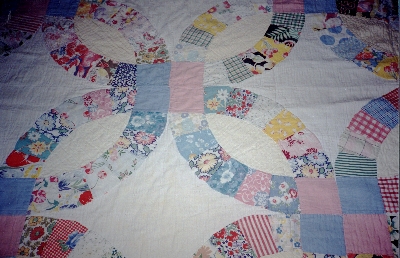Quilt No.627PWH - The Pioneer Women's Hut

2300 x 1880mm
This quilt was made in Sydney in the 1940s by Mrs. Dorothy McMorran and other members of the Canadian Women's Association probably from a McCalls pattern The quilt passed to Dorothy's daughter, Norma McMorran,who donated it to The Pioneer Women's Hut. It is displayed occasionally in the museum.
These quilts were made in the early 1940s by my mother, Mrs. Dorothy McMorran. She was a Canadian who lived in Sydney from 1924 onwards. She came here as a young bride when her husband was sent here to be assistant to the elderly gentleman who at that time represented the Canadian Pacific Railway Company in Australia. Although the appointment was initially for a period of 3 years, it was extended many times and eventually my parents lived in Australia longer than they did in Canada. While loving Australia, they remained very Canadian and thanks to generous 'home' leave were able to maintain their Canadian connections. My mother died in 1974.
She was a very energetic woman with a great interest in handwork - the bigger the project the better. I remember her knitting dresses (she became great friends with the head of the knitting wool department at Farmer's, her favourite store), hooking rugs, crocheting afgahns and in one phase collecting worn out woollen garments to make braided rugs. About 1940 or a little later she was looking for new fields to conquer and was given a McCall pattern for a Dresden Plate quilt by one of the other Canadians living here. It had been brought from Canada and not used.
�����..By this time it was 1946 or 1947 and many members of the group [The Canadian Women's Association] were war brides - Canadian girls who had married Australian R.A.A.F. men training in Canada and many of whom at this stage were battling homesickness, the problems of adapting to a new country and postwar conditions generally. Much homesickness was talked out over the quilting frame and many problems aired. The whole project proved an excellent therapy for these girls.
��..I don't have any clear recollections about how the Double Wedding Ring quilt came to be started except that once the Dresden Plate was finished she had to keep on going. The pattern, probably another McCalls, was likely sent by the friend in Oregon and many of the pieces in it look to have come from the same source."
[Norma McGorran, 1991]

Related Quilts:
2550 x 1870mm
1829 x 1372mm
1524 x 1169mm
1400 x 400mm
2540 x 2490mm






